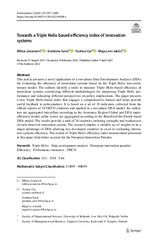Please use this identifier to cite or link to this item:
https://rfos.fon.bg.ac.rs/handle/123456789/2303Full metadata record
| DC Field | Value | Language |
|---|---|---|
| dc.creator | Jovanović, Milica | |
| dc.creator | Savić, Gordana | |
| dc.creator | Cai, Yuzhuo | |
| dc.creator | Levi-Jakšić, Maja | |
| dc.date.accessioned | 2023-05-12T11:40:42Z | - |
| dc.date.available | 2023-05-12T11:40:42Z | - |
| dc.date.issued | 2022 | |
| dc.identifier.issn | 0138-9130 | |
| dc.identifier.uri | https://rfos.fon.bg.ac.rs/handle/123456789/2303 | - |
| dc.description.abstract | This article presents a novel application of a two-phase Data Envelopment Analysis (DEA) for evaluating the efficiency of innovation systems based on the Triple Helix neo-evolutionary model. The authors identify a niche to measure Triple Helix-based efficiency of innovation systems scrutinizing different methodologies for measuring Triple Helix performance and indicating different perspectives on policy implications. The paper presents a new Triple Helix-based index that engages a comprehensive dataset and helps provide useful feedback to policymakers. It is based on a set of 19 indicators collected from the official reports of 34 OECD countries and applied in a two-phase DEA model: the indicators are aggregated into pillars according to the Assurance Region Global and DEA super-efficiency model; pillar scores are aggregated according to the Benefit-of-the-Doubt based DEA model. The results provide a rank of 34 countries outlining strengths and weaknesses of each observed innovation system. The research implies a variable set of weights to be a major advantage of DEA allowing less developed countries to excel in evaluating innovation systems efficiency. The results of Triple Helix efficiency index measurement presented in this paper help better account for the European Innovation Paradox. | en |
| dc.publisher | Springer, Dordrecht | |
| dc.rights | openAccess | |
| dc.rights.uri | https://creativecommons.org/licenses/by/4.0/ | |
| dc.source | Scientometrics | |
| dc.subject | Triple Helix | en |
| dc.subject | Performance measures | en |
| dc.subject | OECD | en |
| dc.subject | European innovation paradox | en |
| dc.subject | Efficiency | en |
| dc.subject | Data envelopment analysis | en |
| dc.title | Towards a Triple Helix based efficiency index of innovation systems | en |
| dc.type | article | |
| dc.rights.license | BY | |
| dc.citation.epage | 2609 | |
| dc.citation.issue | 5 | |
| dc.citation.other | 127(5): 2577-2609 | |
| dc.citation.rank | M22~ | |
| dc.citation.spage | 2577 | |
| dc.citation.volume | 127 | |
| dc.identifier.doi | 10.1007/s11192-022-04304-x | |
| dc.identifier.fulltext | http://prototype2.rcub.bg.ac.rs/bitstream/id/831/2299.pdf | |
| dc.identifier.pmid | 35431365 | |
| dc.identifier.rcub | conv_2646 | |
| dc.identifier.scopus | 2-s2.0-85127704970 | |
| dc.identifier.wos | 000779798800001 | |
| dc.type.version | publishedVersion | |
| item.cerifentitytype | Publications | - |
| item.fulltext | With Fulltext | - |
| item.grantfulltext | open | - |
| item.openairetype | article | - |
| item.openairecristype | http://purl.org/coar/resource_type/c_18cf | - |
| Appears in Collections: | Radovi istraživača / Researchers’ publications | |
This item is licensed under a Creative Commons License


